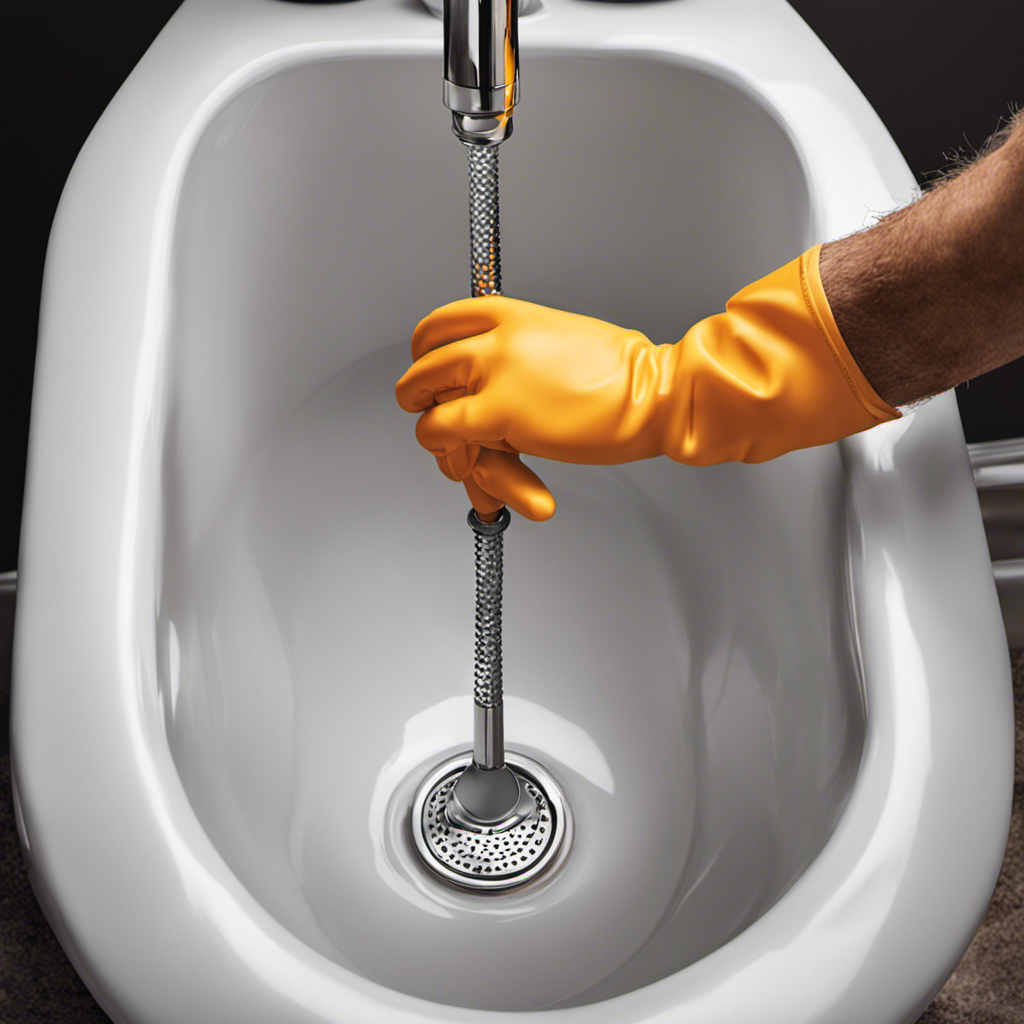Have you ever heard the steady drip-drip-drip coming from underneath your bathtub? It’s a maddening sound, isn’t it? Well, you’re not alone. Many homeowners have faced the frustration of a leaking bathtub, and it’s a problem that needs immediate attention.
In this article, we will explore the common causes of bathtub leaks underneath, the signs to watch out for, and the steps you can take to identify and fix the source of the leak.
So, let’s dive in and put an end to that persistent drip once and for all!
Key Takeaways
- Bathtub leaks underneath can be caused by a worn-out or damaged seal, which can deteriorate over time due to regular use, exposure to chemicals, or age.
- Signs of a bathtub leak include water pooling on the floor near the tub, which can lead to weakened and rotted flooring, as well as a favorable environment for mold and mildew growth.
- To identify the source of the leak, check the caulking for cracks or gaps, ensure the drain is properly sealed, examine the faucet for signs of dripping, and test the overflow drain for leaks.
- Repair options for a leaking bathtub may involve hiring a professional plumber for expertise, conducting a pressure test for leak detection, and replacing seals, repairing pipes, or installing new fixtures. Implementing preventive measures such as regularly inspecting and sealing the caulk and grout, repairing any surface chips or cracks, maintaining the overflow drain, and ensuring proper ventilation can help avoid bathtub leaks and extend the bathtub’s longevity.
Common Causes of Bathtub Leaks Underneath
One of the most common causes of bathtub leaks underneath is a worn-out or damaged seal. The seal, usually made of rubber or silicone, is responsible for preventing water from seeping out of the bathtub and into the flooring or walls. Over time, this seal can deteriorate due to regular use, exposure to chemicals, or simply age. If you suspect a seal issue, it is important to address it promptly to prevent further damage.
Bathtub leak detection can be a complex process, requiring specialized tools and expertise. In such cases, it is recommended to seek professional plumbing services. They have the necessary knowledge and skills to accurately identify and fix the source of the leak.
Now let’s move on to the signs and symptoms of a leaking bathtub.
Signs and Symptoms of a Leaking Bathtub
If you notice water pooling on the floor near your tub, it’s a sign that there might be a leak. A leaking bathtub can lead to potential dangers if left untreated. The water can seep into the flooring, causing it to weaken and potentially rot. This can result in costly repairs and even structural damage to your home.
Additionally, a leaking bathtub can create the perfect environment for mold and mildew to grow, which can be harmful to your health. It’s important to address a leaking bathtub as soon as possible to prevent further damage and potential health risks.
In order to fix the issue, it is recommended to seek professional services for fixing bathtub leaks. A professional plumber can accurately diagnose the cause of the leak and provide the necessary repairs to ensure a safe and leak-free bathtub.
Steps to Identify the Source of the Leak
To identify the source of the leak, you can start by checking the caulking around the edges of the bathtub. This is a common area where leaks can occur. Here are four troubleshooting tips to help you pinpoint the cause of the leak:
-
Inspect the caulking: Look for any cracks or gaps in the caulking around the bathtub. If there are any, water could be seeping through and causing the leak.
-
Check the drain: Make sure the drain is properly sealed and that there are no loose or damaged parts. A faulty drain can lead to water leakage.
-
Examine the faucet: Inspect the faucet for any signs of dripping or water pooling around the handles. Faulty faucets are a common cause of bathtub leaks.
-
Test the overflow drain: Fill the bathtub with water and check the overflow drain. If water is leaking from this area, it may indicate a problem with the overflow drain assembly.
Timely detection and repair of bathtub leaks is crucial to prevent further damage to your bathroom and to avoid costly water bills.
Repair Options for a Leaking Bathtub
Consider hiring a professional plumber to fix the leak in your bathtub, as they have the expertise and necessary tools to properly repair it. A leaking bathtub can cause significant damage if not addressed promptly. Professional bathtub repair services offer a range of options to address different types of leaks. One common method used for bathtub leak detection is a pressure test. This involves applying pressure to the plumbing system to identify any leaks. Once the source of the leak is identified, the plumber can proceed with the appropriate repair method. This may involve replacing faulty seals, repairing damaged pipes, or installing new fixtures. Hiring a professional ensures that the repair is done correctly, preventing further damage and providing peace of mind.
| Repair Options | Description | Benefits |
|---|---|---|
| Replacing seals | Old or worn-out seals are a common cause of bathtub leaks. Replacing them can effectively stop the leak. | Prevents water damage, extends the lifespan of the bathtub, restores proper functionality. |
| Repairing pipes | Damaged or corroded pipes can cause leaks. Repairing or replacing the affected pipes ensures a permanent solution. | Stops leaks, prevents further damage, maintains water pressure. |
| Installing new fixtures | Faulty or outdated fixtures can contribute to leaks. Installing new fixtures can provide a long-term solution. | Improves water flow, enhances the overall appearance of the bathtub, reduces the risk of future leaks. |
Preventive Measures to Avoid Bathtub Leaks Underneath
Regularly maintaining your bathtub can help prevent leaks from occurring underneath. Here are four essential bathtub maintenance and waterproofing techniques to ensure the longevity and integrity of your bathtub:
-
Seal the seams: Inspect the caulk and grout around your bathtub regularly. If you notice any cracks or gaps, remove the old sealant and reapply a fresh layer to create a watertight seal.
-
Repair any chips or cracks: Small cracks or chips in your bathtub’s surface can lead to water seepage. Use a bathtub repair kit to fix any imperfections promptly.
-
Check the overflow drain: The overflow drain is a common source of leaks. Make sure it is tightly sealed and functioning correctly. Replace any worn-out gaskets or components as needed.
-
Maintain proper ventilation: Adequate ventilation helps prevent moisture buildup, which can lead to mold and mildew growth. Install a bathroom exhaust fan and ensure it is functioning optimally.
Frequently Asked Questions
Can a Leaking Bathtub Cause Damage to the Surrounding Walls or Flooring?
A leaking bathtub can potentially cause water damage to the surrounding walls and flooring. Look out for signs such as dampness, discoloration, or mold growth, which could indicate a leaking bathtub.
How Long Does It Take to Repair a Leaking Bathtub?
Repairing a leaking bathtub typically takes a few hours to a couple of days, depending on the extent of the damage and the specific repairs needed. Common causes of leaks include worn-out seals, cracked pipes, or faulty plumbing fixtures.
Is It Possible to Fix a Leaking Bathtub Without Professional Help?
Fixing a leaking bathtub without professional help is possible, but not recommended. DIY bathtub repair may lead to more damage or incomplete fixes. Common causes of bathtub leaks include worn-out seals, loose connections, or cracked pipes.
Can a Bathtub Leak Be a Sign of a Larger Plumbing Issue?
A bathtub leaking repair may indicate a larger plumbing issue. Signs like water pooling underneath your tub or low water pressure could suggest problems with pipes or drains. It’s best to seek professional help.
What Are the Consequences of Ignoring a Leaking Bathtub?
Ignoring a leaking bathtub can have serious consequences. Water damage can occur, leading to mold growth, structural damage, and expensive repairs. It’s crucial to address the issue promptly to prevent further problems.
Conclusion
In conclusion, if you notice that your bathtub is leaking underneath, it’s important to address the issue promptly to prevent further damage. By identifying the source of the leak and utilizing the appropriate repair options, you can effectively resolve the problem.
For example, let’s consider a hypothetical case where a homeowner discovers a bathtub leak underneath due to a cracked pipe. By replacing the damaged pipe and implementing preventive measures, such as regular inspections and caulking maintenance, the homeowner successfully prevents future leaks and ensures the longevity of their bathtub.










